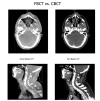Cone Beam CT vs. Fan Beam CT: A Comparison of Image Quality and Dose Delivered Between Two Differing CT Imaging Modalities
- PMID: 27752404
- PMCID: PMC5063198
- DOI: 10.7759/cureus.778
Cone Beam CT vs. Fan Beam CT: A Comparison of Image Quality and Dose Delivered Between Two Differing CT Imaging Modalities
Abstract
A comparison of image quality and dose delivered between two differing computed tomography (CT) imaging modalities-fan beam and cone beam-was performed. A literature review of quantitative analyses for various image quality aspects such as uniformity, signal-to-noise ratio, artifact presence, spatial resolution, modulation transfer function (MTF), and low contrast resolution was generated. With these aspects quantified, cone beam computed tomography (CBCT) shows a superior spatial resolution to that of fan beam, while fan beam shows a greater ability to produce clear and anatomically correct images with better soft tissue differentiation. The results indicate that fan beam CT produces superior images to that of on-board imaging (OBI) cone beam CT systems, while providing a considerably less dose to the patient.
Keywords: cbct; dose; fan beam; fbct; image quality; uniformity.
Conflict of interest statement
The authors have declared that no competing interests exist.
Figures



References
-
- Evaluation of image quality for different kV cone- beam CT acquisition and reconstruction methods in the head and neck region. Elstrøm U, Muren L, Peterson J, Grau C. Acta Oncologica. 2011;50:908–917. - PubMed
-
- A study on image quality provided by a kilovoltage cone-beam computed tomography. [Mar;2016 ];Garayoa J, Castro P. http://www.jacmp.org/index.php/jacmp/article/view/3888 J Appl Clin Med Phys. 2013 14:239–257. - PMC - PubMed
-
- Sir Godfrey Hounsfield. Richmond C. http://dx.doi.org/10.1136/bmj.329.7467.687 BMJ. 2004;329:687.
-
- A (short) history of image-guided radiotherapy. Verellen D, De Ridder M, Storme G. Radiother Oncol. 2008;86:4–13. - PubMed
-
- Assessment of spatial resolution in CT. Grimmer R, Krause J, Karolczak M, Lapp R, Kachelriess M. http://ieeexplore.ieee.org/stamp/stamp.jsp?tp=&arnumber=4774508&isnumber... IEEE Nucl Sci Symp Conf Rec. 2008:5562–5566.
Publication types
LinkOut - more resources
Full Text Sources
Other Literature Sources
Miscellaneous
